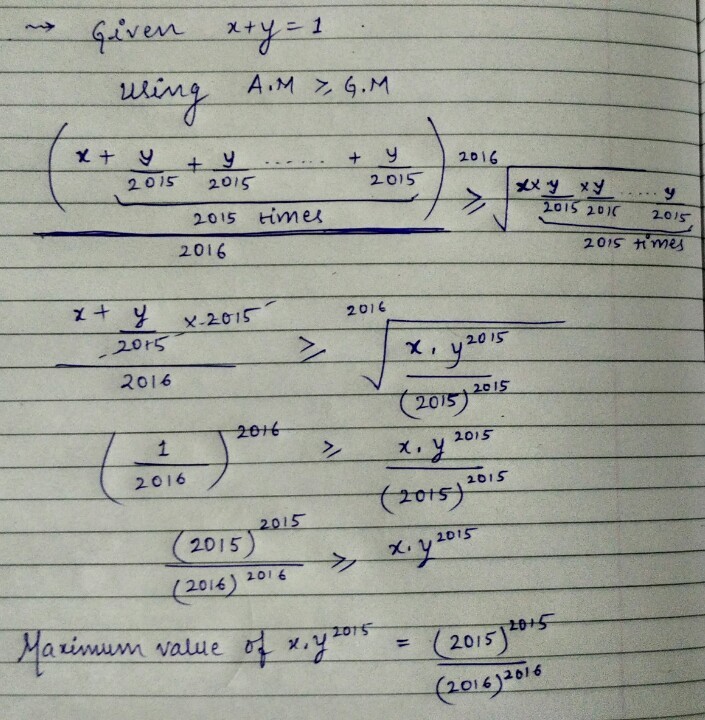Inequality Problem
If x and y are non-negative numbers such that x + y = 1 , find the maximum value of x y 2 0 1 5 .
This section requires Javascript.
You are seeing this because something didn't load right. We suggest you, (a) try
refreshing the page, (b) enabling javascript if it is disabled on your browser and,
finally, (c)
loading the
non-javascript version of this page
. We're sorry about the hassle.
3 solutions

Jonathan Hocker , I hope u will get it this way also :)
Log in to reply
Nice solution, Raj. It might be worth noting for sake of completeness that this maximum is achieved when y = 2 0 1 6 2 0 1 5 and x = 2 0 1 6 1 . The maximum value achieved is approximately 2 0 1 6 e 1 .
Log in to reply
Thanks :) have you done this question with inequality or any other way ??
Log in to reply
@Raj Rajput – Like Jonathan I used calculus, finding the critical points of the function f ( y ) = ( 1 − y ) y 2 0 1 5 . I knew that the AM-GM inequality was the intended method, (since the question is tagged Algebra), but I wasn't sure how to apply it in this case, so I've learned something from your solution. :)
nice to see that i am not the only one here who doesnt know how to write in latex :p . or maybe you did it that way because it saved time ?
Log in to reply
both, i don't know how to use latex and yeah it saves time too :)
Did the same
Here is a very similar solution, except made for all the L A T E X lovers :) Enjoy!
Note that by AM-GM, we see that 2 0 1 6 x + 2 0 1 5 1 y + 2 0 1 5 1 y + ⋯ + 2 0 1 5 1 y ≥ 2 0 1 6 x ⋅ 2 0 1 5 y ⋯ 2 0 1 5 y = 2 0 1 6 2 0 1 5 2 0 1 5 x y 2 0 1 5 . Now we raise both sides to the 2 0 1 6 th power: ( 2 0 1 6 x + 2 0 1 5 1 y + ⋯ + 2 0 1 5 1 y ) 2 0 1 6 = ( 2 0 1 6 2 0 1 6 1 ) ≥ 2 0 1 5 2 0 1 5 x y 2 0 1 5 . Finally, we isolate x y 2 0 1 5 to get our answer: 2 0 1 6 2 0 1 6 2 0 1 5 2 0 1 5 ≥ x y 2 0 1 5 . So our answer must be max x y 2 0 1 5 = 2 0 1 6 2 0 1 6 2 0 1 5 2 0 1 5 .
Moderator note:
Simple standard approach.
Simple use of AM GM inequality. Split y into 2015 equal parts and apply AM>=GM as both x & y are positive.
Sorry to bother you but could you go into more detail in your solution? Like a step by step so I can see how it comes together. I'm trying to learn how to solve inequalities using AM-GM and Cauchy-Schwarz inequalities but sometimes it's hard for me to get a handle on applying them in a useful way. I cheated and solved it using calculus lol...
Log in to reply
Check out Applying the Arithmetic Mean Geometric Mean Inequality , which lists several basic ways of seeing it's application.
Log in to reply
Thanks for all the solutions and explanations everyone! I am beginning to see the light finally lol. Seeing a step by step has been very helpful in understanding the thought process behind applying the theorem and how to break up the products/sums in order to get a useful result. And thank you for the link Calvin Lin. I'll give that a read and keep practicing.